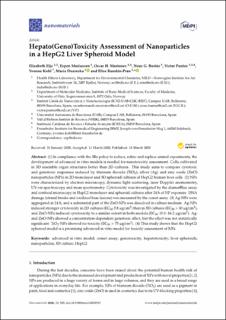Hepato(Geno)Toxicity Assessment of Nanoparticles in a HepG2 Liver Spheroid Model
Elje, Elisabeth; Mariussen, Espen; Moriones, Oscar H.; Bastus, Neus G.; Puntes, Victor; Kohl, Yvonne; Dusinska, Maria; Rundén-Pran, Elise
Peer reviewed, Journal article
Published version
Permanent lenke
https://hdl.handle.net/11250/2648397Utgivelsesdato
2020Metadata
Vis full innførselSamlinger
- Publikasjoner fra Cristin - NILU [1360]
- Vitenskapelige publikasjoner [1096]
Sammendrag
(1) In compliance with the 3Rs policy to reduce, refine and replace animal experiments, the development of advanced in vitro models is needed for nanotoxicity assessment. Cells cultivated in 3D resemble organ structures better than 2D cultures. This study aims to compare cytotoxic and genotoxic responses induced by titanium dioxide (TiO2), silver (Ag) and zinc oxide (ZnO) nanoparticles (NPs) in 2D monolayer and 3D spheroid cultures of HepG2 human liver cells. (2) NPs were characterized by electron microscopy, dynamic light scattering, laser Doppler anemometry, UV-vis spectroscopy and mass spectrometry. Cytotoxicity was investigated by the alamarBlue assay and confocal microscopy in HepG2 monolayer and spheroid cultures after 24 h of NP exposure. DNA damage (strand breaks and oxidized base lesions) was measured by the comet assay. (3) Ag-NPs were aggregated at 24 h, and a substantial part of the ZnO-NPs was dissolved in culture medium. Ag-NPs induced stronger cytotoxicity in 2D cultures (EC50 3.8 µg/cm2) than in 3D cultures (EC50 > 30 µg/cm2), and ZnO-NPs induced cytotoxicity to a similar extent in both models (EC50 10.1–16.2 µg/cm2). Ag- and ZnO-NPs showed a concentration-dependent genotoxic effect, but the effect was not statistically significant. TiO2-NPs showed no toxicity (EC50 > 75 µg/cm2). (4) This study shows that the HepG2 spheroid model is a promising advanced in vitro model for toxicity assessment of NPs.

